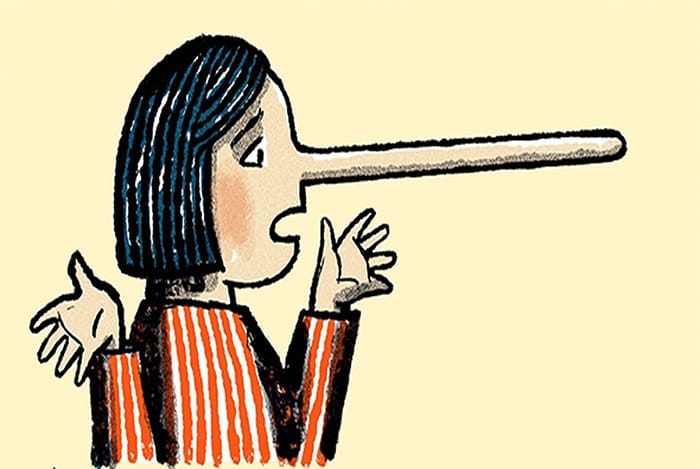
Blog
a lie

Throughout evolution, humans have resorted to lying to preserve their image or to cover up reality. A lie is a false statement that the individual knows is false but uses it to achieve specific goals.
Lying has become ingrained in humans over many years of evolution. Our ancestors constantly resorted to tricks and deceit to stay safe from predatory animals. However, now that humans are no longer at risk of being hunted by any predatory animal and as they become more evolved and use more of their gray cells, it is expected that they would lie less, while the opposite is observable.
People who resort less to lying, deception, and trickery experience higher physical and mental health, while those who lie more are at a lower level in terms of physical and mental health.
فهرست عناوین
Toggle
Who lies more?
Power-seeking individuals: Consider a couple who have come to a couples therapist to repair their relationship, and one of the partners, to show power and maintain control, starts presenting false statements and lying to preserve their image in front of the therapist.
Narcissistic Personality Disorder: Narcissistic individuals lie and exaggerate certain matters to preserve their image and standards because they constantly strive to present themselves as bigger, smarter, more powerful, and better than they actually are, making small issues appear large and significant.
Narcissistic individuals usually gather victims around themselves and exploit them through lies and deception. It is worth mentioning that narcissists fall into two categories: the strong narcissists and the weak narcissists, who are usually victims of the strong narcissists. The relationship between these two is such that strong narcissists excite weak narcissists with lies, deception, and trickery, playing with their emotions. This continues until the weak narcissists gradually realize the exploitation by the strong narcissists and withdraw from the relationship.
Antisocial Personality Disorder: These individuals are compulsive liars and constantly lie to manipulate and deceive others.
Fear: Fear and its consequences, including fear of losing a job, social status, housing, spouse, child, or even basic life necessities, can lead to resorting to lies.
In societies where people are stuck in the lower levels of the hierarchy of needs or, in other words, are considered poor, lying is more prevalent.
People who fear humiliation are also major liars; in this case, demands and expectations on these individuals are high, leading them to believe that if they do not meet others’ expectations, they will be seen as insignificant and small in their eyes.
Professional Liars: Some individuals are professional liars; these people do not lie because of the aforementioned reasons but because they enjoy lying.
Korsakoff Syndrome: It is worth noting that this syndrome is different from alcoholism, but with long-term alcohol consumption, the brain sometimes changes shape and loses control. In this state, the individual makes false statements and lies more frequently.
Suggested article: Appearance characteristics of liars

Types of Lies
- Male Lies: Usually when men lie, they consider their shortcomings and limitations, and this type of lie differs from the lies told by women. Men lie to appear bigger than they are and to exaggerate their possessions. For example, a man may earn 10 million monthly but claim to earn 30 million to exaggerate.
- Female Lies: The nature of lies among women is usually friendly and can also be seen in covering up the faults and mistakes of their children in front of the father or others. For instance, when their child comes home late, a mother might lie by saying she knew where the child was and what they were doing.
Suggested article: Why Are We Attracted to Narcissists?

Cultural and Social Foundations of Lying
Some cultural and social foundations influence the prevalence of lying, and unfortunately, this has caused lying to be more widespread in our society. The proverb “keeping one’s face red with a slap” illustrates this issue. In our society, people try to maintain dignity and hide their faults to appear better, which provides the grounds for lying to preserve appearances.
For example, a divorced person who still wears a wedding ring after divorce to make others think they are married.
Or another person who has been laid off due to downsizing but still tries to show others that they are employed and in good condition.
In societies like ours, due to the existence of the phenomenon of “taarof” (social etiquette and politeness), the amount of lying is more than in other societies. For example, consider a person who could not eat all day due to work but when invited to a gathering, lies saying they just ate and are not hungry because of customary taarof.
Or another example: you ask a friend, “How is your father?”
They reply, “He sends his regards!”
While in reality, their father is not even aware of your conversation.
When the social system and regulations in a society are incomplete, that society resorts to lying and trickery. Extreme social etiquette foundations are also considered social reasons for lying, such as sitting cross-legged in the presence of elders, which damages the knees and spine.
Or not drinking water during class to show respect to the teacher, which over time causes kidney failure and other problems.
برای مشاوره رایگان و رزرو وقت (یا اگر تماس گرفتید و قادر به پاسخگویی نبودیم) شماره تماس خود را وارد کنید. ما به زودی با شما تماس می گیریم!



